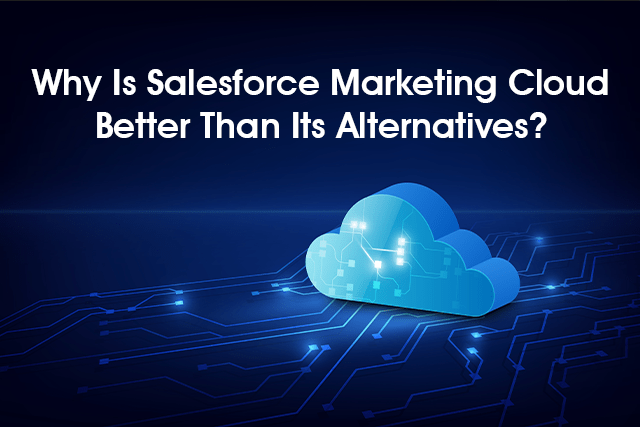We run campaigns, we send emails, and we promote content on different platforms – All are marketing.
With traditional marketing, all these tedious tasks are manually performed. This time-taking convoluted task is crucial for engaging customers and closing more leads in no time. But diverting the marketing team’s focus from strategic planning to executing tedious tasks.
However, when it comes to automating tasks, improving efficiency, and maximizing leads, Salesforce Marketing Cloud implementation wins more than its alternatives. It provides robust features and capabilities with comprehensive solutions to optimize your business’s marketing strategies. Also, its advanced functionalities, such as personalized customer journeys, multi-channel campaign management, and powerful data analytics, allow you to deliver tailored solutions to your customers.
Furthermore, the versatile platform provides seamless integration with third-party applications, automating tasks, customer reports and insights to drive greater efficiency, effectiveness, and better results over its alternatives.
Let’s dive deeper into how the Salesforce Marketing Cloud wins over its popular alternatives in the competitive landscape.
Considering alternatives to Marketing Salesforce Cloud? See what other B2B prefer in their purchasing decision. When evaluating solution-oriented planning, potential buyers leave no stone unturned to compare with alternative options.
#1. HubSpot Vs. Salesforce Marketing Cloud
| HubSpot Marketing Cloud | Salesforce Marketing Cloud |
| This platform is designed keeping SMBs in mind. It primarily focuses on inbound marketing, content creation, and lead generation. | It delivers services to businesses of all sizes, focusing on catering to enterprises-level organizations with marketing automation and customer engagement capabilities. |
| It offers a comprehensive suite of tools for inbound marketing, content management, email marketing, social media management, and lead nurturing. It emphasizes simplicity and user-friendliness. | It offers advanced features for personalized customer journeys, multi-channel campaign management, data analytics, and integration to cater to large-scale marketing automation and enterprise-level needs. |
| With a range of native integrations with popular third-party apps, you can integrate marketing-oriented applications from the HubSpot marketplace. | Integrates seamlessly with the broader Salesforce ecosystem, allowing more advanced integration than HubSpot. |
| You can choose the freemium model with basic features and unlock advanced on paid subscriptions. | It comes with a hefty price tag, meaning you must spend a bit higher than HubSpot to unlock the premium features. |
| You can experience a better and user-friendly (UI) interface and easy-to-use templates within your budget. | With a little complicated user interface, it requires a clear platform understanding to engage prospects or generate leads. |
#2. Pardot Vs. Salesforce Marketing Cloud
| Pardot Marketing Cloud | Salesforce Marketing Cloud |
| It primarily focuses on B2B marketing automation. | Salesforce Marketing Cloud caters to both B2B and B2C industry |
| You can utilize various platform tools for lead generation, lead nurturing, and sales alignment. | You can unlock extensive features to deliver tailored solutions to your customers. |
| It focuses on B2B-oriented leads, leads scoring and emails throughout the sales funnel. | It focused on B2B and B2C leads, leveraging its robust functionalities. |
| Native integration is possible with Salesforce CRM to align sales and marketing tasks. | It offers a vast array of integration capabilities across the Salesforce ecosystem. |
#3. Marketo Vs. Salesforce Marketing Cloud
| Marketo Marketing Cloud | Salesforce Marketing Cloud |
| It can organize and manage small businesses with simplified data. | It can manage and handle enterprise-level organizations’ convoluted data in a simplified manner. |
| It focuses on B2B marketing automation, lead management, and account-based marketing. | You can visualize end-to-end customer journeys using the journey builder tool. |
| It primarily focuses on Email campaigns. | It’s winning the game when it comes to marketing on omnichannel. |
| Accessing and modifying the content creation editor is easier in Salesforce Marketing Cloud. | You need to juggle with HTML/CSS for accessing or modifying the content creation editor in Marketo. |
#4. MailChimp Vs. Salesforce Marketing Cloud
| MailChimp Marketing Cloud | Salesforce Marketing Cloud |
| It is convenient to leverage because of its friendly user interface. | The user interface is a bit complex, creating trouble for customers in interaction. |
| It offers primary automation features, landing page creation, and limited CRM functionality. | You can create custom objects to enable the support team for flexible work cases. |
| This email-oriented platform can handle a large volume of emails but fail to cater to large-enterprise requirements. | It is designed to meet the evolving demands of large enterprises, managing their data seamlessly. |
| You can manage subscriber lists, segmentations, and basic customer profiles. | You can manage and track customer interactions across various channels, build comprehensive customer profiles, and leverage customer data for personalized marketing campaigns. |
In a Nutshell,
As you went through the marketing (MKT Cloud) cloud alternatives and capabilities of the Salesforce platform. Salesforce Marketing Cloud outshines its alternative in terms of scalability, flexibility, features, and integration capabilities. It offers a holistic approach to marketing automation, simplifying workflows and eliminating the need for multiple systems.
Additionally, marketing in Salesforce is like a cakewalk because of its actionable insights and continuous improvement when hiring a Salesforce Marketing Cloud Implementation partner or Salesforce consulting company for your business. You can simplify relying on your partner without hustling with day-to-day tasks, soaring your business growth.



